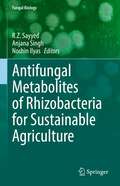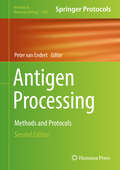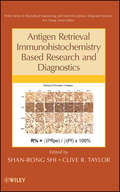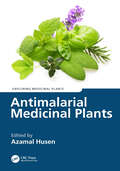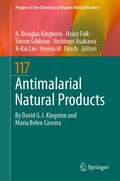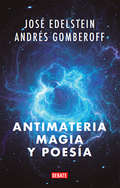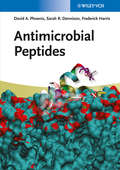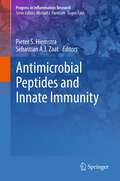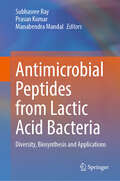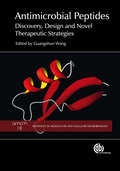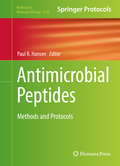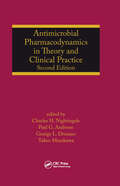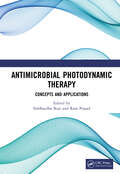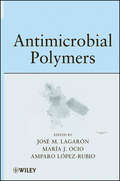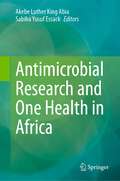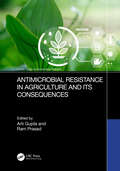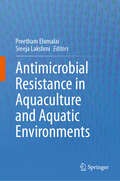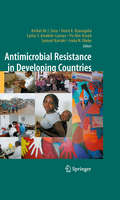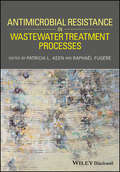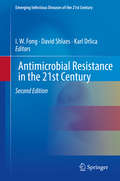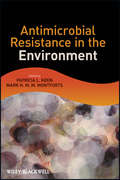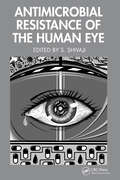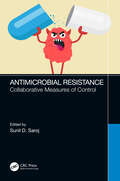- Table View
- List View
Antifungal Metabolites of Rhizobacteria for Sustainable Agriculture (Fungal Biology)
by R. Z. Sayyed Anjana Singh Noshin IlyasAntifungal Metabolites of Rhizobacteria for Sustainable Agriculture focuses on plant health in agro-ecosystems of various economically important cash and food crops with a concern to promote sustainable agriculture. They have emerged as a key organic tool for enhancing yields. In a natural environment the interactions between plants and phytopathogenic fungi are complex and survival requires a development of resistance to plant diseases. Diversity of Plant Growth Promoting Rhizobacteria (PGPR) diversity depends on the nature of root exudates and soil conditions that affect their interaction with host plants. Novel strategies, such as, applying bioactive natural products against the pathogenic fungus are required to control disease sustainably. Various classes of secondary metabolites including lipopeptides, macrolides, alkaloids, terpenoids and phenolics from microorganisms and plants strongly suppress fungal growth and can also be effective in controlling plant diseases both in vitro and in vivo. The modes of actions of some potential antifungal secondary metabolites against pathogenic fungus are also discussed.Eco-friendly fungal species and their metabolites are excellent agents used for regulating various fungal and bacterial phytopathogens and may have tremendous potential for other applications, and play a key role in enhancing plant tolerance to stress. Antifungal Metabolites of Rhizobacteria for Sustainable Agriculture also covers bovine-based formulations used for sustainable production and nutritional security through horticultural crops, thereby addressing the problems associated with malnutrition and under-nutrition encountered by small and marginal farmers, as well as by families facing resource constraints. These techniques can also improve breathable air, drinkable water, and consumable foods. This book addresses the need to mitigate the health problems of people via organic crop production and to improve the socio-economic status of farmers (especially in developing countries), and to revitalize agricultural sustainability.
Antigen Processing: Methods and Protocols (Methods in Molecular Biology #1988)
by Peter Van EndertThe second edition volume expands on the previous edition with new and updated chapters on the latest methods used for studying presentation of antigenic peptides produced in the standard processing pathways for MHC class I and II molecules. The new chapters cover topics such as biochemical and cellular approaches to study the impact of the endoplasmic reticulum aminopeptidases; techniques to monitor MHC class I synthesis and degradation; approaches to measure processing efficacy; description of different assays measuring MHC recycling; and protocols to produce MHC class II tetramers. Written in the highly successful Methods in Molecular Biology series format, chapters include introductions to their respective topics, lists of the necessary materials and reagents, step-by-step, readily reproducible laboratory protocols, and tips on troubleshooting and avoiding known pitfalls. Cutting-edge and comprehensive, Antigen Processing: Methods and Protocols, Second Edition is a valuable tool for both novice and expert researchers interested in studying antigen processing and venturing out further into this evolving field.
Antigen Retrieval Immunohistochemistry Based Research and Diagnostics (Wiley Series in Biomedical Engineering and Multi-Disciplinary Integrated Systems #5)
by Shan-Rong Shi Clive R. TaylorThe most complete, up-to-date reference on antigen retrieval and immunohistochemistry An antigen is a substance that prompts the generation of antibodies and can cause an immune response. The antigen retrieval (AR) technique is in wide use across the globe, and is a critical technique used in medical diagnosis of disease, particularly clinical targeted cancer treatment. Antigen Retrieval Immunohistochemistry Based Research and Diagnostics discusses several scientific approaches to the standardization of quantifiable immunohistochemistry (IHC). Based on the development and application of AR by the editors, this volume summarizes recent achievements in AR-IHC and analyzes numerous cutting-edge issues for future research projects. Featuring contributions from a worldwide group of leading experts and research scientists in the field, this important work: Summarizes the key problems in the four fields of antigen retrieval Discusses the advances of AR techniques and their applications Provides practical methods and protocols in AR-IHC, such as extraction of nucleic acids and proteins for molecular analysis, cell/tissue sample preparation, and standardization and development of various techniques to meet the future needs of¿clinical and research molecular analysis Encourages further research in AR and IHC, particularly how AR methods might be employed for improved test performance and the development of greater reliability and reproducibility of IHC Includes an appendix of related laboratory protocols Antigen Retrieval Immunohistochemistry Based Research and Diagnostics is intended for clinical pathologists, molecular cell biologists, basic research scientists, technicians, and graduate students who undertake tissue/cell morphologic and molecular analysis and wish to use and extend the power of immunohistochemistry. It is also pertinent for most biotechnology companies majoring in development of IHC products. Wiley Series in Biomedical Engineering and Multi-Disciplinary Integrated Systems / Kai Chang, Series Editor
Antihydrogen and Fundamental Physics: Testing Fundamental Physics (SpringerBriefs in Physics)
by Michael Charlton Stefan Eriksson Graham M. ShoreThe advent of high-precision antihydrogen spectroscopy has opened up the possibility of direct tests with unprecedented accuracy of some of the most fundamental principles of physics, notably Lorentz and CPT symmetry and the Einstein equivalence principle.This book reviews these principles, emphasising their interconnections in quantum field theory and general relativity and the special role of antimatter, and explores how they may be tested in current and forthcoming experiments on antihydrogen. Original research results relevant to the experimental programme of the ALPHA collaboration at CERN are presented, together with the implications for antihydrogen of proposed theories featuring novel `fifth-force' interactions.
Antimalarial Medicinal Plants (Exploring Medicinal Plants)
by Azamal HusenMalaria continues to affect a large population of the world, especially in third world countries. The spread of drug-resistant parasites demonstrates the need for antimalarial agents with various modes of action. The search for remedies derived from medicinal plants for the treatment of malaria is reliant on accurate ethnobotanical and ethnopharmacological information obtained from traditional medical practitioners. Antimalarial Medicinal Plants provides information on bioactive compounds and therapeutic potentials of several antimalarial plant species found around the globe. This book evaluates these plant species with respect to their biology, diversity, distribution, and pharmacological values.A volume in the Exploring Medicinal Plants series, this book highlights trends, technologies, processes, and services important to and necessary for efficient production, use, and understanding of medicinal qualities of antimalarial plants. It critically examines claims made by traditional medical practitioners with scientific validations for safe herbal drug formulation. It is a reference work for researchers of herbal medicine, traditional healers, pharmacists, and students associated with plant sciences and economic botany.
Antimalarial Natural Products (Progress in the Chemistry of Organic Natural Products #117)
by A. Douglas Kinghorn Heinz Falk Simon Gibbons Yoshinori Asakawa Ji-Kai Liu Verena M. DirschThis volume begins with a short history of malaria and follows with a summary of its biology. It then traces the fascinating history of the discovery of quinine for malaria treatment, and then describes quinine’s biosynthesis, its mechanism of action, and its clinical use, concluding with a discussion of synthetic antimalarial agents based on quinine’s structure. It also covers the discovery of artemisinin and its development as the source of the most effective current antimalarial drug, including summaries of its synthesis and biosynthesis, its mechanism of action, and its clinical use and resistance. A short discussion of other clinically used antimalarial natural products leads to a detailed treatment of additional natural products with significant antiplasmodial activity, classified by compound type. Although the search for new antimalarial natural products from Nature’s combinatorial library is challenging, it is very likely to yield new antimalarial drugs. This book thus ends by identifying ten natural products with development potential as clinical antimalarial agents.
Antimateria, magia y poesía
by ANDRES GOMBEROFF JOSÉ EDELSTEINEl nuevo libro de los autores de Einstein para perplejos, Andrés Gomberoff y José Edelstein. En su nuevo libro, Andrés Gomberoff y José Edelstein reúnen un conjunto de veintitrés ensayos que se ofrecen como un muestrario, insuficiente pero necesario, de pequeñas joyas, hitos inverosímiles, momentos estelares que pueblan la construcción de la más humana de las actividades: la ciencia. Luego del éxito de Einstein para perplejos, esta nueva colaboración pretende celebrar aquellos instantes en los que la exploración científica se dejó llevar por una visión poética e integradora del cosmos, sea a través de la serena elegancia de la geometría o del proceloso torrente de la intuición.
Antimatter: What It Is and Why It's Important in Physics and Everyday Life
by Beatriz Gato-RiveraAntimatter is one of the most fascinating aspects of Particle Physics, and matter-antimatter annihilation the most energetic process in the universe. If they existed, everyday objects made of antimatter would look exactly like those made of ordinary matter, as would antimatter stars. We live surrounded by antimatter, since showers of matter and antimatter particles fall incessantly on the Earth's surface, some of them penetrating our buildings. Furthermore, many things around us - bananas, for example - actually emit antielectrons.This book first introduces the essentials of particle physics and the nature of particles and antiparticles. It describes the discovery of antimatter particles and explains how they are produced, where they are found, and how antistars could be spotted; it also introduces cosmic rays, particle accelerators, dark matter, dark energy and nuclear reactions in stars. The enigma of the matter-antimatter asymmetry in the Universe is discussed as are the very real applications of antimatter in hospitals, in industry and in cutting-edge research and technology, Non-specialist readers will find here a wealth of fascinating and accessible information to deepen their appreciation of antimatter.
Antimicrobial Peptides
by David A. Phoenix Frederick Harris Sarah R. DennisonIn this text, the small team of expert authors presents the field in a comprehensive and accessible manner that is well suited for students and junior researchers.The result is a highly readable and systematically structured introduction to antimicrobial peptides, their structure, biological function and mode of action. The authors point the way towards a rational design of this potentially highly effective new class of clinical antibiotics on the brink of industrial application. They do this by discussing their design principles, target membranes and structure-activity relationships. The final part of the book describes recent successes in the application of peptides as anticancer agents.
Antimicrobial Peptides and Innate Immunity (Progress in Inflammation Research)
by Sebastian A. Zaat Pieter S. HiemstraAntimicrobial peptides have been the subject of intense research in the past decades, and are now considered as an essential part of the defense system in bacteria, plants, animals and humans. his book provides an update on these effector molecules of the innate immune system both for researchers who are already actively involved in the area, and for those with a general interest in the topic. The book starts with an overview of the evolution of cysteine-containing antimicrobial peptides (including defensins), and the role of these peptides in host defense in plants and micro-organisms. The realization that antimicrobial peptides also display functions distinct from their direct antimicrobial action is the focus of the next chapters, and puts these peptides center stage in immunity and wound repair. Further chapters discuss the role of antimicrobial peptides in disease, by providing an overview of mechanisms in bacterial resistance to antimicrobial peptides and a discussion of their role in inflammatory bowel disease, cystic fibrosis lung disease and chronic obstructive pulmonary disease. Finally, the book shows how knowledge of the function of antimicrobial peptides and their regulation can be used to design new therapies for inflammatory and infectious disorders. This is a very important area of research because of the increase in resistance of micro-organisms to conventional antibiotics. Therefore the use of synthetic or recombinant peptides, or agents that stimulate the endogenous production of antimicrobial peptides, provides an attractive alternative for conventional antibiotics.
Antimicrobial Peptides from Lactic Acid Bacteria: Diversity, Biosynthesis and Applications
by Prasun Kumar Subhasree Ray Manabendra MandalAntimicrobial peptides (AMPs) have been sought to be a potential alternative to the current arsenal of antibiotics against undesirable microbes. AMPs synthesized by lactic acid bacteria have attracted significant attention due to their strong activity against a broad range of bacteria including pathogens. The bacteriocin (an AMP) has been known to us since early 1928, a year before penicillin was reported. This is possibly due to their narrower activity compared to antibiotics. However, several AMPs having promising activity have been thoroughly characterized in the past few decades. Renewed interest has developed focusing on industrially important bacteriocins produced by lactic acid bacteria. Some of these AMPs are also active against food spoilage and clinically important pathogens. Similar to antibiotics, large-scale intellectual screening is ongoing in the search for novel AMPs with unique properties. Recent research has revealed that AMPs may also play a role in maintaining gut microflora and keeping us protected from food-borne pathogens. The ongoing genomic studies suggest that there may be more such bioactive compounds waiting to be explored. This book provides an overview of the fundamental knowledge accumulated so far regarding the diversity and potential applications of AMPs produced by lactic acid bacteria. This updated reference book on AMPs from lactic acid bacteria is timely, covering the most important achievements in the field and providing the scientific community particularly graduate students, researchers, and clinicians with the latest updates. The goal of this book is to illustrate and detail the findings made so far, debate the state of the art, and draw new perspectives.
Antimicrobial Peptides: Discovery, Design and Novel Therapeutic Strategies
by Guangshun WangThis 18th in the series of Advances in Molecular and Cellular Microbiology, examines new technologies such as bioinformatics, combinatorial libraries, high-throughput screening, peptidomimetics, biophysics, and structural biology, in addition to covering the current advances in AMP research. This volume also describes new methods and strategies for AMP prediction, design, and applications that overcome obstacles in developing them into therapeutic agents.
Antimicrobial Peptides: Methods and Protocols (Methods in Molecular Biology #Volumbe 1548)
by Paul R. HansenThis volume provides basic and advanced laboratory protocols for the non-specialist and the experienced researcher. Chapters are divided into three parts covering synthesis and characterization of AMPs, studying the interaction of AMPs with model systems or bacteria, and assaying selected biological activities of AMPs. <P><P>Written in the highly successful Methods in Molecular Biology series format, chapters include introductions to their respective topics, lists of the necessary materials and reagents, step-by-step, readily reproducible laboratory protocols, and tips on troubleshooting and avoiding known pitfalls.
Antimicrobial Pharmacodynamics in Theory and Clinical Practice
by George L. Drusano Takeo Murakawa Charles H. NightingaleTaking readers from the research laboratory to the bedside, this Second Edition compiles essential information on the pharmacodynamics of all major classes of the antimicrobial armamentarium including penicillins, cephalosposorins, cephamycins, carbapenems, monobactams, aminoglycosides, quinolones, macrolides, antifungals, antivirals, and emerging
Antimicrobial Photodynamic Therapy: Concepts and Applications
by Ram Prasad Siddhardha BusiAntimicrobial Photodynamic Therapy: Concepts and Applications explores the novel antimicrobial therapeutic technique. As the world searches for new, efficient modalities for fighting microorganisms, this book offers a complete understanding of the concept, and knowledge about the emerging technique ‘antimicrobial photodynamic therapy’ (aPDT) for the scientific communities and budding researchers. The book aligns concepts, significance, and applications of the technique systematically. Chapters in the book cover microorganisms, pathogenesis, conventional treatment methods, and significance of new treatment approaches to the concept of antimicrobial photodynamic therapy. The authors describe the mechanism behind it, with applications and examples from research studies. The book discusses photosensitisers in detail, with one chapter emphasising natural photosensitisers. Use of nanostructures in the antimicrobial photodynamic therapy is elaborated on, and we conclude with a well-explored application of the therapeutic technique in dentistry. Features: Efficiently covers the topic in detail with scientifically proven examples. Applications of the therapeutic approach are well discussed, and readers can learn about the research gaps, challenges, and future of the technique. Starts from basics, enabling readers to understand why the approach is relevant and important for study. Simplistic elucidated concepts and applications make it accessible at all levels.
Antimicrobial Polymers
by Maria Jose Ocio Jose Maria Lagaron Amparo Lopez-RubioThe pioneering guide on the design, processing, and testing of antimicrobial plastic materials and coatingsThe manifestation of harmful microbes in plastic materials used in medical devices and drugs, water purification systems, hospital equipment, textiles, and food packaging pose alarming health threats to consumers by exposing them to many serious infectious diseases. As a result, high demand for intensifying efforts in the R&D of antimicrobial polymers has placed heavy reliance on both academia and industry to find viable solutions for producing safer plastic materials. To assist researchers and students in this endeavor, Antimicrobial Polymers explores coupling contaminant-deterring biocides and plastics--focusing particular attention on natural biocides and the nanofabrication of biocides. Each chapter is devoted to addressing a key technology employed to impart antimicrobial behavior to polymers, including chemical modification of the polymers themselves. A host of relevant topics, such as regulatory matters, human safety, and environmental risks are covered to help lend depth to the book's vital subject matter. In addition, Antimicrobial Polymers:Discusses the design, processing, and testing of antimicrobial plastic materialsCovers interdisciplinary areas of chemistry and microbiologyIncludes applications in food packaging, medical devices, nanotechnology, and coatingsDetails regulations from the U.S. (FDA and EPA) and EU as well as human safety and environmental concernsAchieving cleaner and more effective methods for improving the infection-fighting properties of versatile and necessary plastic materials is a goal that stretches across many scientific fields. Antimicrobial Polymers combines all of this information into one volume, exposing readers to preventive strategies that harbor vast potential for making exposure to polymeric products and surfaces a far less risky undertaking in the future.
Antimicrobial Research and One Health in Africa
by Akebe Luther King Abia Sabiha Yusuf EssackAntimicrobial resistance is recognised among the world’s most challenging problems. Despite its global spread, Africa, specifically sub-Saharan Africa, is the most affected by this malaise. Poor living conditions and inadequate access to sanitation and potable water supplies are among contributing factors that have influenced a high disease burden on the continent, requiring extensive antimicrobials. Weak health systems and the absence of firm policies further aggravate the problem, as the use of antimicrobials is mostly unregulated. The increasing demand for animal protein to meet the starving populations’ demands has also influenced the use of these antimicrobials, including those banned on other continents, for food animal production. The ripple effect of indiscriminate use in humans and animals is the massive discharge of antimicrobials, their residues, antimicrobial-resistant microorganisms and their associated genes into the environment. This 14-chapter unique masterpiece presents the AMR problem in African, addressing the various compartments of the One Health – humans, animals, and the environment, to illustrate the need for concerted efforts in the fight against AMR, especially in Africa. Authors from the four cardinal points present diverse aspects of AMR in Africa, starting with behavioural and social drivers of AMR in Africa. Antimicrobial stewardship in an African context is also discussed. AMR in humans is presented through studies on antibiotic-resistant neonates and nontyphoidal Salmonella infections and the clinical relevance of the genetics of viral resistance. Topics on AMR in mastitis, biosecurity in animal farming and the linkage between disinfectants and AMR are discussed. The environmental dimension of AMR is discussed, notably in the aquatic environment, and its implication for aquaculture and irrigation and using nanomaterials to treat polluted waters from such environments are highlighted. Finally, Africa’s rich floral diversity is portrayed as an eco-friendly and cost-effective approach to combat AMR. Hopefully, the work presented will spur greater collaboration between scientists, environmental, animal and human health practitioners, the general population, and policymakers to assimilate and implement the One Health approach to combating AMR, rather than working in silos on their various sectors
Antimicrobial Resistance in Agriculture and its Consequences (Current Trends in Antimicrobial Research)
by Ram Prasad Arti GuptaThis book offers comprehensive coverage of all manifestations of resistance in combating infectious diseases and explores advances in antimicrobial resistance in agriculture and their applications in the fight against microbes. It discusses and compares biological, biochemical, and structural aspects of resistance and its evolution. This is a comprehensive tool covering all manifestations of antimicrobial resistance and microbial resistance genes. In addition, it also provides a variety of photographs, diagrams, and tables to help illustrate the material. Novel strategies to combat antimicrobial resistance are also described, emphasizing collaborative measures of control. The underlining molecular mechanisms, which depend not only on the microbe but on the specific drug (target) molecule, are highly diverse and are covered in great detail.Students, researchers, scientists, practitioners, academics, computational biologists, stakeholders, and policymakers can benefit from using Antimicrobial Resistance in Agriculture and its Consequences as a resource that addresses microbial biotechnology, microbiology, ethnopharmacology, toxicology, medicinal plant products, and all disciplines related to antimicrobial research.Features of the book: Covers antimicrobial resistance in agriculture with up-to-date research Includes recent references on each plausible antimicrobial resistance in agriculture Details the possible spread of antibiotic resistance bacteria from animals to humans Provides several perspectives in the resistance flux with modern agricultural practices Describes the public health impact of the use of antibiotics in agriculture Presents cutting-edge research on epigenetics, nanotechnology, and emergent antimicrobial technologies Outlines recent laws and regulatory guidelines in the federal agency, responsibility, and authority
Antimicrobial Resistance in Aquaculture and Aquatic Environments
by Preetham Elumalai Sreeja LakshmiThis book provides the latest information on aquatic AMR from the perspective of inflammation and presents new ideas on the complicated mechanisms of lectin biochemistry and associated interactions. Key features include discussion of mechanisms recently identified to be involving surveillance and monitoring of AMR and AMU, presentation of the latest evidence regarding the molecular approaches in disease therapeutics, and thorough explanation of the concept of one health challenges and current understanding of the significance of its disease resistance related studies. Gene expression studies is another important element of the book, and it is proposed that gene editing technology provides gaining attention in the biological role of fresh water and marine environments. Examples of the many latest molecular approaches, applications and future perspectives in AMR specific topics covered in this book include the information right from the basics to the advancements in this area. The book will be a valuable update and resource for both experienced and younger researchers working in the field of marine biology and immunology.
Antimicrobial Resistance in Developing Countries
by Samuel Kariuki Carlos F. Amábile-Cuevas Po-Ren Hsueh Iruka N. Okeke Denis K. Byarugaba Aníbal De SosaToday, there is considerable literature regarding the subject of antimicrobial resistance. However, most of this information is based on information from developed countries. Very little organized information is available about the subject that critically examines the problem in developing countries. Scattered literature is available in various forms in journals that are often not easily accessible to the affected developing countries. The objective of the book is to put together data and information about the problem of antimicrobial resistance in developing countries addressing the general global perspectives, the risk factors, the current rates, trends, and possibilities for containment as they relate to specific conditions in those developing countries.
Antimicrobial Resistance in Wastewater Treatment Processes
by Patricia L. Keen Raphaël FugèreAntimicrobial resistance is arguably the greatest threat to worldwide human health. This book evaluates the roles of human water use, treatment and conservation in the development and spread of antimicrobial resistance. Designed as a companion volume to Antimicrobial Resistance in the Environment (Wiley-Blackwell, 2012), this book is a multi-disciplinary synthesis of topics related to antimicrobial resistance and wastewater treatment processes. Antimicrobial Resistance in Wastewater Treatment Processes assembles detailed discussions written by many of the world's best-known experts in microbiology, civil engineering, chemistry, environmental science, public health and related fields. The book presents a collection of subjects that includes: Current knowledge of the role of the environment in development and spread of antimicrobial resistance Chemical analysis of antibiotics in environmental samples Molecular methods for analysis of antimicrobial resistance genes Advanced wastewater treatment processes and antimicrobial resistance effects Public perception of risk related to health consequences of antimicrobial resistance Public health implications of antimicrobial resistance with focus on wastewater treatment processes Antimicrobial resistance has gained a foothold in the global consciousness as a serious public health threat. There is a much greater appreciation for the role of the environment in the dissemination of antimicrobial resistance and the effects of pollutants that can potentially promote development of resistance in bacteria. Contaminants released from wastewater treatment plants are a concern. In Antimicrobial Resistance in Wastewater Treatment Processes, readers will be guided through examinations of the current science related to this important health issue.
Antimicrobial Resistance in the 21st Century (Emerging Infectious Diseases of the 21st Century)
by I. W. Fong David Shlaes Karl DrlicaThis comprehensive, up-to-date volume defines the issues and offers potential solutions to the challenges of antimicrobial resistance. The chapter authors are leading international experts on antimicrobial resistance among a variety of bacteria, viruses including HIV and herpes, parasites and fungi. The chapters explore the molecular mechanisms of drug resistance, the immunology and epidemiology of resistance strains, clinical implications and implications on research and lack thereof, and prevention and future directions.
Antimicrobial Resistance in the Environment
by Patricia L. Keen Mark H. MontfortsExamines effects of the environmental distribution of antimicrobial resistance genes on human health and the ecosystem Resistance genes are everywhere in nature—in pathogens, commensals, and environmental microorganisms. This contributed work shows how the environment plays a pivotal role in the development of antimicrobial resistance traits in bacteria and the distribution of resistant microbial species, resistant genetic material, and antibiotic compounds. Readers will discover the impact of the distribution in the environment of antimicrobial resistance genes and antibiotics on both the ecosystem and human and animal health. Antimicrobial Resistance in the Environment is divided into four parts: Part I, Sources, including ecological and clinical consequences of antibiotic resistance by environmental microbes Part II, Fate, including strategies to assess and minimize the biological risk of antibiotic resistance in the environment Part III, Antimicrobial Substances and Resistance, including antibiotics in the aquatic environment Part IV, Effects and Risks, including the effect of antimicrobials used for non-human purposes on human health Recognizing the intricate links among overlapping complex systems, this book examines antimicrobial resistance using a comprehensive ecosystem approach. Moreover, the book's multidisciplinary framework applies principles of microbiology, environmental toxicology, and chemistry to assess the human and ecological risks associated with exposure to antibiotics or antibiotic resistance genes that are environmental contaminants. Each chapter has been written by one or more leading researchers in such fields as microbiology, environmental science, ecology, and toxicology. Comprehensive reference lists at the end of all chapters serve as a gateway to the primary research in the field. Presenting and analyzing the latest findings in a field of growing importance to human and environmental health, this text offers readers new insights into the role of the environment in antimicrobial resistance development, the dissemination of antimicrobial resistant genetic elements, and the transport of antibiotic resistance genes and antibiotics.
Antimicrobial Resistance of the Human Eye
by S. ShivajiThe book covers antimicrobial resistance in ocular diseases, including the microbiology of the ocular surface, the history and origin of antimicrobials, methods to detect antimicrobial resistance and antimicrobial resistance genes, and the impact of antimicrobial resistance on a variety of ocular diseases. The inclusion of chapters covers bacterial keratitis, fungal keratitis, viral keratitis, acanthamoeba keratitis, endophthalmitis, dry eye disease, post fever retinitis, and uveitis including management and prevention of antimicrobial resistance.Key Features: Focusses on various ocular diseases and their association with antimicrobial resistance; Includes data relevant to drug industry to develop drugs for specific ophthalmic use; Illustrates ocular surface microbiome under various diseased condition;s Highlights the microbes associated with the conjunctiva and cornea of the human eye; Enumerates the changes in the abundance and diversity of the antimicrobial resistant (AMR) microorganisms in the diseased eye. This book is aimed at professionals and researchers in ophthalmology, microbiologists, infectious disease specialists, and public health.
Antimicrobial Resistance: Collaborative Measures of Control
by Sunil D. SarojAntimicrobial resistance has existed in nature long before the discovery of antibiotics. The mechanisms of resistance are prevalent among the bacterial population. Over a period of time and facilitated by indiscriminate usage of antibiotics, these mechanisms are transferred from one type of bacteria to another, including the pathogenic ones. In addition, the rate of discovery of novel antimicrobials is much slower than the rate of evolution of antimicrobial resistance. Therefore, there is a need for alternative strategies to control antimicrobial resistance to save lives. In this book, the novel strategies to combat antimicrobial resistance are described, emphasizing collaborative measures of control. We describe the concerted efforts undertaken by global communities to combat antimicrobial resistance in detail. The most efficient strategy could be a behavioral change towards indiscriminate consumption, usage, and prescription of antibiotics.
